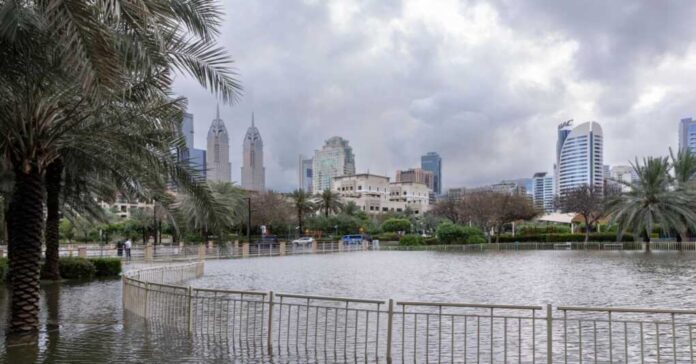
If you haven’t heard, the United Arab Emirates, as well as parts of Oman, received record-breaking amounts of rainfall last week. The question is whether or not all that rain was caused by Mother Nature or weather tampering…
According to local meteorologist data, it began raining in the UAE on Monday, continuing through the night. By Tuesday morning, around 9 am, the rain intensified into a torrential downpour that continued most of the day.
By Tuesday evening, when the rain finally stopped, the capital desert city of Dubai had received a whopping 5.59 inches or 142mm of rain in just one 24-hour period.
Now, that might not seem like a whole lot to you or me, especially if you live somewhere like Seattle, where rain is a near-daily occurrence. But for the Arabian peninsula, this is indeed significant.
On average, Dubai receives a measly 3.73 inches (86mm) of rain in an entire year. So, this was well over a year, and nearly two years, worth of rain in a single day. To be clear, this is the most rain the UAE has ever seen in one day, according to records, which began in 1949.
Naturally, such a downpour causes some problems.
So much rain in such a short time frame caused massive flooding. Schools were shut down, businesses closed, homes were evacuated, and even the Dubai International Airport was ground to a halt for a while.
Now, normally, we could chalk this up to some freak storm just passing over the area. But in Dubai, weather isn’t always such a natural occurrence.
You see, in the UAE, as well as several other nations around the world that tend to receive less than ideal rainfall, governments have begun practicing what is essentially weather tampering or control, although based on Tuesday’s rainfall, I’d say there is less “control” than one would like.
More specifically, the practice is known as pluviculture or cloud seeding.
Due to the nation’s general lack of rain, the government flies small planes through clouds in the area, which burn special salt flares to encourage small rain droplets to stick together. Naturally (or not so naturally) this creates larger droplets which eventually get heavy enough to fall to Earth in the form of rain or snow.
The practice has been used fairly widely for about 50 years now, with the UAE as one of the hottest and driest regions on Earth, beginning its “rounds” of cloud seeding in 2002.
Regarding Tuesday’s downpours, the UAE’s National Center of Meteorology (NCM) has admitted that they flew six or seven cloud-seeding flights before the rains began on Sunday and Monday.
But is that what caused such torrential rain?
Well, it most likely had a hand to play, although it can’t be the only culprit.
According to experts, cloud seeding effectiveness is not necessarily conclusive. Some studies have shown that it can increase rainfall by as much as 35 percent. However, it can’t cause a storm like the one Dubai just experienced.
One thing to remember is that the Arabian Peninsula doesn’t typically receive natural rain like you and I usually experience, you know, periodic showers. Instead, because of its extremely dry climate, it usually happens in infrequent but severe bursts.
On Tuesday, the NCM had predicted a storm that would bring a sizeable amount of rain. Warnings had even been sent out. But no one imagined that much rain.
Thanks to cloud seeding, the expected rainfall likely increased a bit.
Of course, once the rain is on the ground in places like Dubai, things are also different. Unlike the place where I call home, with fertile soil and fields that stretch for miles, the rain is not simply soaked up or eventually makes its way to local waterways.
In Dubai, the city was built on the basis of not having water. So, there’s a lot of paved surfaces and sandy ground covered by impenetrable materials. Therefore, when it rains like this, drainage systems can become quite easily overwhelmed, forcing water into places it shouldn’t be, such as homes and roadways.
Suffice it to say that cities like Dubai, just aren’t designed for heavy rains or floods.
And that’s certainly what they got Tuesday.
Of course, leftists and some scientists say this is all the work of global warming, that the warmer temperature of our climate is more likely to cause severe rainfall in some areas.
I’m not so sure. I mean, we are talking about messing with Mother Nature’s patterns here. Who knows what that will cause…















